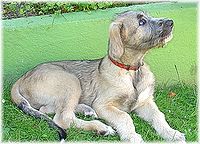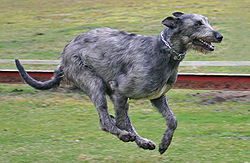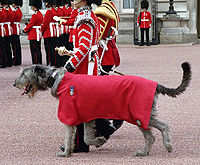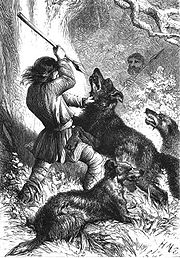
Irish Wolfhound
Encyclopedia
The Irish wolfhound is a breed
Dog breed
Dog breeds are groups of closely related and visibly similar domestic dogs, which are all of the subspecies Canis lupus familiaris, having characteristic traits that are selected and maintained by humans, bred from a known foundation stock....
of domestic dog (Canis lupus familiaris), specifically a sighthound
Sighthound
Sighthounds, also called gazehounds, are hounds that primarily hunt by speed and sight, instead of by scent and endurance as scent hounds do.-Appearance:...
. The name originates from its purpose (wolf hunting
Wolf hunting with dogs
Wolf hunting with dogs is a method of wolf hunting which relies on the use of hunting dogs. While any dog, especially a hound used for hunting wolves may be loosely termed a "wolfhound," several dog breeds have been specifically bred for the purpose, some of which, such as the Irish Wolfhound,...
) rather than from its appearance. Irish Wolfhounds are the tallest of dog breeds.
Appearance
The standard of The American Kennel ClubAmerican Kennel Club
The American Kennel Club is a registry of purebred dog pedigrees in the United States. Beyond maintaining its pedigree registry, this kennel club also promotes and sanctions events for purebred dogs, including the Westminster Kennel Club Dog Show, an annual event which predates the official...
describes the breed as "Of great size and commanding appearance, the Irish Wolfhound is remarkable in combining power and swiftness with keen sight. The largest and tallest of the galloping hounds, in general type he is a rough-coated, Greyhound-like breed; very muscular, strong though gracefully built; movements easy and active; head and neck carried high, the tail carried with an upward sweep with a slight curve towards the extremity". The colours allowed by the American Kennel Club
American Kennel Club
The American Kennel Club is a registry of purebred dog pedigrees in the United States. Beyond maintaining its pedigree registry, this kennel club also promotes and sanctions events for purebred dogs, including the Westminster Kennel Club Dog Show, an annual event which predates the official...
are "grey, brindle, red, black, pure white, fawn, wheaten and steel grey". The American Kennel Club allows "any other color that appears in the Deerhound". The size as specified by the AKC is "Minimum height for males: 79cm (31.1in), females: 71cm (27.95ins). Minimum weight: 54.5kg (120.15lbs) for males, 40.9kg (90.16lbs) for females. Great size, including height of shoulder and proportionate length of body is to be aimed at, and it is desired to firmly establish a breed that shall average (minimum) from 81-86cm (31.88-33.85in) in dogs".
Temperament
An easygoing animal, Irish wolfhounds are quiet by nature. Wolfhounds often create a strong bond with their family and can become quite destructive or morose if left alone for long periods of time. Despite the need for their own people, wolfhounds generally are somewhat stand-offish with total strangers. They should not be territorially aggressive to other domestic dogs but are born with specialized skills and it is common for hounds at play to courseCoursing
Coursing is the pursuit of game or other animals by dogs—chiefly greyhounds and other sighthounds—catching their prey by speed, running by sight and not by scent. Coursing was a common hunting technique, practised by the nobility, the landed and wealthy, and commoners with sighthounds and lurchers...
another dog. This is a specific hunting behavior, not a fighting or territorial domination behavior. Most wolfhounds are very gentle with children and are aware of their size and power. The Irish wolfhound is relatively easy to train. They respond well to firm, but gentle, consistent leadership. However, historically these dogs were required to work at great distances from their masters and think independently when hunting rather than waiting for detailed commands and this can still be seen in the breed.
The wolfhound of today is far from the one that struck fear into the hearts of the Ancient Romans. Irish wolfhounds are often favored for their loyalty, affection, patience and devotion. Although at some points in history they have been used as watchdogs, unlike some breeds, the Irish wolfhound is usually unreliable in this role as they are often friendly toward strangers, although their size can be a natural deterrent. That said, when protection is required this dog is never found wanting. When they or their family are in any perceived danger they display a fearless nature. Author and Irish wolfhound breeder Linda Glover believes the dogs' close affinity with humans makes them acutely aware and sensitive to ill will or malicious intentions leading to them excelling as a guardian rather than guard dog.
Health

Osteosarcoma
Osteosarcoma is an aggressive cancerous neoplasm arising from primitive transformed cells of mesenchymal origin that exhibit osteoblastic differentiation and produce malignant osteoid...
are the leading cause of death and like all deep-chested dogs, gastric torsion (bloat) is common; the breed is affected by hereditary intrahepatic portosystemic shunt
Portosystemic shunt
A portosystemic shunt , also known as a liver shunt, is a bypass of the liver by the body's circulatory system. It can be either a congenital or acquired condition....
.
In a privately funded study conducted under the auspices of the Irish Wolfhound Club of America and based on an owner survey, Irish wolfhounds in the United States from 1966 to 1986 lived to a mean age of 6.47 and died most frequently of bone cancer. A more recent study by the UK Kennel Club puts the average age of death at 7 years.
Irish wolfhounds should not receive additional supplements when a good dog food is used. It is generally accepted that they should be fed a low protein adult dog food (19 to 21% protein) from puppyhood onward. Most breeders today recommend that they not be supplemented to slow their rapid growth.
Irish wolfhounds are the tallest of all dog breeds. They are well suited to rural life, but their medium energy profile allows them to adjust fairly well to suburban and urban life as well, provided they receive appropriate exercise.
History

Early Irish literature
-The earliest Irish authors:It is unclear when literacy first came to Ireland. The earliest Irish writings are inscriptions, mostly simple memorials, on stone in the ogham alphabet, the earliest of which date to the fourth century...
, from the old Irish period - AD 600-900. The breed almost disappeared, but was successfully revived by efforts of the captain of the British Army D E Graham to recreate it, he drew the line related wolfhounds As a result, has developed a modern breed Irish Wolfhounds Today they are well established themselves as companions and guards. The word "Cu" often became an added respected prefix on the names of warriors, such as Cú Chulainn
Cú Chulainn
Cú Chulainn or Cúchulainn , and sometimes known in English as Cuhullin , is an Irish mythological hero who appears in the stories of the Ulster Cycle, as well as in Scottish and Manx folklore...
, the Hound of Ulster
Ulster
Ulster is one of the four provinces of Ireland, located in the north of the island. In ancient Ireland, it was one of the fifths ruled by a "king of over-kings" . Following the Norman invasion of Ireland, the ancient kingdoms were shired into a number of counties for administrative and judicial...
, as well as kings denoting that they were worthy of the respect and loyalty of a Cu.
Pre-19th century
Ancient wood cuts and writings have placed them in existence as a breed by 273 BC. However there is indication that they existed even as early as 600 BC when the Tectosages and TolistobogiiTolistobogii
Tolistobogii is the name used by the Roman historian, Livy, for one of the three ancient Celtic tribes of Galatia in central Asia Minor, together with the Trocmi and Tectosages...
Celts sacked Delphi. Survivors left accounts of the fierce Celts and the huge dogs who fought with them and at their side. They were mentioned by Julius Caesar
Julius Caesar
Gaius Julius Caesar was a Roman general and statesman and a distinguished writer of Latin prose. He played a critical role in the gradual transformation of the Roman Republic into the Roman Empire....
in his treatise, The Gallic Wars
Commentarii de Bello Gallico
Commentarii de Bello Gallico is Julius Caesar's firsthand account of the Gallic Wars, written as a third-person narrative. In it Caesar describes the battles and intrigues that took place in the nine years he spent fighting local armies in Gaul that opposed Roman domination.The "Gaul" that Caesar...
, and by 391 BC, they were written about by Roman Consul, Quintus Aurelius Symmachus
Quintus Aurelius Symmachus
Quintus Aurelius Symmachus was a Roman statesman, orator, and man of letters. He held the offices of governor of Africa in 373, urban prefect of Rome in 384 and 385, and consul in 391...
, who received seven of them as a gift to be used for fighting lions, bears, that in his words, "all Rome viewed with wonder".
Bred as hunting dogs by the ancients, who called them Cú Faoil. The Irish continued to breed them for this purpose, as well as to guard their homes and protect their stock. Cúchulain, a name which translates literally as "hound of Culain", gained his name when as a child, known then as Setanta, he slew the ferocious guard dog of Culain forcing him to offer himself as a replacement.


Gelert
Gelert is the name of a legendary dog associated with the village of Beddgelert in Gwynedd, northwest Wales. The story of Gelert is a variation on the well-worn "Faithful Hound" folk-tale motif, which lives on as an urban legend...
to Llewellyn
Llywelyn the Great
Llywelyn the Great , full name Llywelyn ab Iorwerth, was a Prince of Gwynedd in north Wales and eventually de facto ruler over most of Wales...
, a prince of Wales
Wales
Wales is a country that is part of the United Kingdom and the island of Great Britain, bordered by England to its east and the Atlantic Ocean and Irish Sea to its west. It has a population of three million, and a total area of 20,779 km²...
. The poet The Hon William Robert Spencer
William Robert Spencer
William Robert Spencer , English poet and wit, was the younger son of Lord Charles Spencer and his wife Mary Beauclerk. He was the grandson of Charles Spencer, 3rd Duke of Marlborough on his father's side and Vere Beauclerk, 1st Baron Vere on his mother's...
immortalised this hound in a poem.
In his Historie of Ireland completed 1571, Blessed Edmund Campion
Edmund Campion
Saint Edmund Campion, S.J. was an English Roman Catholic martyr and Jesuit priest. While conducting an underground ministry in officially Protestant England, Campion was arrested by priest hunters. Convicted of high treason by a kangaroo court, he was hanged, drawn and quartered at Tyburn...
gives a description of the hounds used for hunting the wolves on the Dublin and Wicklow mountains
Wicklow Mountains
The Wicklow Mountains form the largest continuous upland area in Ireland. They occupy the whole centre of County Wicklow and stretch outside its borders into Counties Carlow, Wexford and Dublin. Where the mountains extend into County Dublin, they are known locally as the Dublin Mountains...
. He says: They (the Irish) are not without wolves and greyhounds to hunt them, bigger of bone and limb than a colt. Due to their popularity overseas many were exported to European royal houses leaving numbers in Ireland depleted. This led to a declaration by Oliver Cromwell
Oliver Cromwell
Oliver Cromwell was an English military and political leader who overthrew the English monarchy and temporarily turned England into a republican Commonwealth, and served as Lord Protector of England, Scotland, and Ireland....
himself being published in Kilkenny
Kilkenny
Kilkenny is a city and is the county town of the eponymous County Kilkenny in Ireland. It is situated on both banks of the River Nore in the province of Leinster, in the south-east of Ireland...
on 27 April 1652 to ensure that sufficient numbers remained to control the wolf population.
References to the Irish wolfhound in the 18th century tell of its great size, strength and greyhound shape as well as its scarcity. Writing in 1790, Bewick described it as the largest and most beautiful of the dog kind; about 36 inches high, generally of a white or cinammon colour, somewhat like the greyhound but more robust. He said that their aspect was mild, disposition peaceful, and strength so great that in combat the mastiff or bulldog was far from being an equal to them. The last wolf in Ireland is thought to have been killed at Myshall, Co Carlow in 1786 by a pack of wolfdogs kept by a Mr Watson of Ballydarton. The remaining hounds in the hands of a few families who were mainly descendants of the old Irish chieftains, were now symbols of status rather than hunters, they were said to be the last of their race.
Modern wolfhound
Englishman Captain George Augustus Graham is responsible with a few other breeders for reaffirming the dogs' existence. In 1879 he wrote: "It has been ascertained beyond all question that there are few specimens of the breed still left in Ireland and England to be considered Irish wolfhounds, though falling short of the requisite dimensions. This blood is now in my possession." Captain Graham devoted his life to ensuring the survival of the Irish wolfdog. Owing to the small numbers of surviving specimens outcrossing was used in the breeding programme. It is believed that Great DaneGreat Dane
The Great Dane , also known as German Mastiff or Danish Hound , is a breed of domestic dog known for its giant size...
, Deerhound
Scottish Deerhound
The Scottish Deerhound, or simply the Deerhound, is a breed of hound , once bred to hunt the Red Deer by coursing.- Appearance :The Scottish Deerhound resembles a rough-coated Greyhound. It is however, larger in size and bone...
and Mastiff
English Mastiff
The English Mastiff, referred to by virtually all Kennel Clubs simply as the Mastiff, is a breed of large dog perhaps descended from the ancient Alaunt through the Pugnaces Britanniae. Distinguishable by enormous size, massive head, and a limited range of colors, but always displaying a black mask,...
dogs all played their part in Graham's creation of the dog we currently know. In 1885 Captain Graham with other breeders founded the Irish Wolfhound Club, and the Breed Standard of Points to establish and agree the ideal to which breeders should aspire.
The Irish wolfhound is sometimes regarded as the national dog breed of Ireland but in fact no breed has ever been officially adopted as such. The wolfhound was historically a dog that only nobles could own and was taken up by the British during their rule in Ireland. This made it unpopular as a national symbol and the Kerry Blue Terrier
Kerry Blue Terrier
The Kerry Blue Terrier is a breed of dog. Mistakenly thought to be from County Kerry in South West Ireland, it's actually from Tipperary in South Central Ireland. In Ireland it is often called the Irish Blue Terrier...
was adopted by Republicans such as Michael Collins
Michael Collins (Irish leader)
Michael "Mick" Collins was an Irish revolutionary leader, Minister for Finance and Teachta Dála for Cork South in the First Dáil of 1919, Director of Intelligence for the IRA, and member of the Irish delegation during the Anglo-Irish Treaty negotiations. Subsequently, he was both Chairman of the...
. However, in recent years, the wolfhound has been adopted as a symbol by both rugby codes
Rugby football
Rugby football is a style of football named after Rugby School in the United Kingdom. It is seen most prominently in two current sports, rugby league and rugby union.-History:...
, which are organised on an All-Ireland basis. The national rugby league team
Ireland national rugby league team
The Ireland national rugby league team, known as the Wolfhounds, represent the island of Ireland in rugby league football. The team is organized by Rugby League Ireland and are accredited as an affiliate member of the Rugby League International Federation...
are nicknamed the wolfhounds, and the Irish Rugby Football Union
Irish Rugby Football Union
The Irish Rugby Football Union is the body managing rugby union in Ireland. The IRFU has its head office at 10/12 Lansdowne Road and home ground at Aviva Stadium, where Irish rugby union international matches are played...
, which governs rugby union, changed the name of the country's A (second-level) national team in that code to the Ireland Wolfhounds in 2010.
External links
- Irish Wolfhound Club of Ireland
- Irish Wolfhound at Open Directory ProjectOpen Directory ProjectThe Open Directory Project , also known as Dmoz , is a multilingual open content directory of World Wide Web links. It is owned by Netscape but it is constructed and maintained by a community of volunteer editors.ODP uses a hierarchical ontology scheme for organizing site listings...
.

